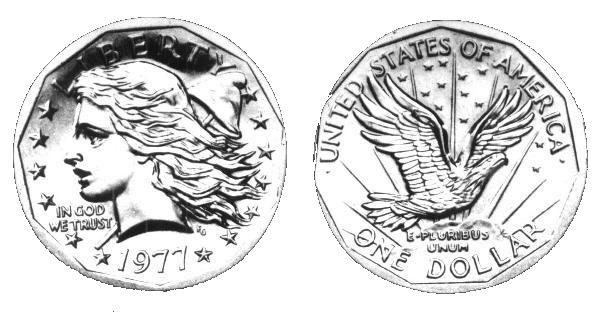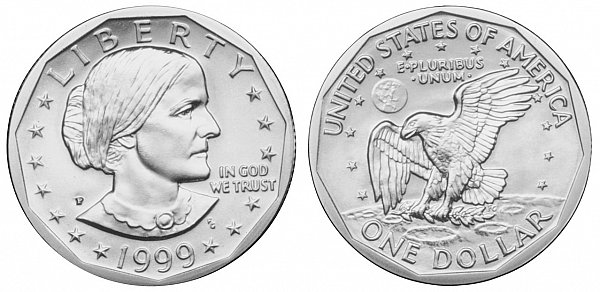Frank Gasparro
US Chief Coin Designer and Engraver - Designed Lincoln Memorial Cent, Kennedy Half Dollar, Eisenhower Dollar and Susan B. Anthony Dollar
Frank Gasparro was born on August 26, 1909 on the centennial year of the birth of Abraham Lincoln and only 24 days after the Lincoln Cent was first produced. He was born in Philadelphia, Pennsylvania as the oldest of 7 children. Gasparro's father was a musician and he wanted his son to continue working in the same profession. Although while Frank was growing up, he began growing an interest in drawings. His father would fume whenever he saw the drawings and would tear them up, because he held the view that artists are the ones who starve to death. As time went on, his father finally realized that his son was not going to stop and so sent his son to the Philadelphia Graphic Sketch Club (known today as the Samuel S. Fleischer Art Memorial). Later, he had Frank Gasparro become an apprentice, who would work under the guidance of Giuseppe Donato, a prominent sculptor who had worked as a foreman for Auguste Rodin.
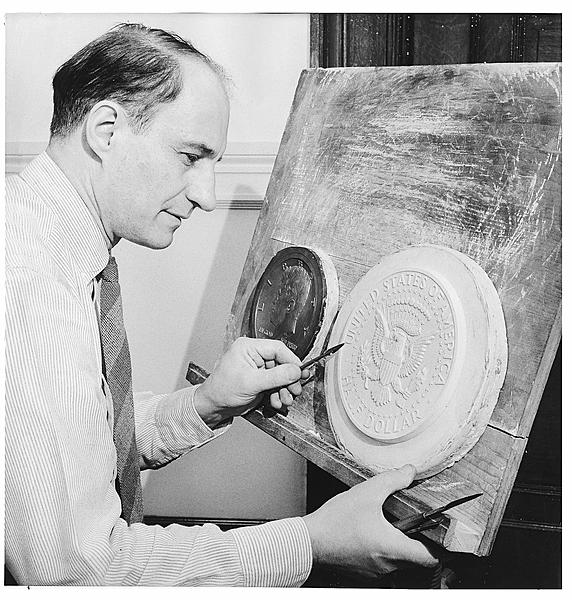
Frank Gasparro - Artist and designer of US coins - Tenth Chief Engraver and Sculptor of the US Mint.
Gasparro eventually joined the Pennsylvania Academy of the Fine Arts, which many prominent artists had done at the time. He earned scholarships and traveled to Europe where he could learn more about the long, rich and fine history of art in that region of the world. Frank became fond of the Greek style of art in particular. Over the years, he would master various skills in the arts of sculpting and modeling before returning to the United States. After coming home, he worked at Works' Progress Administration (WPA) and also worked as a freelance artist, doing various commissions during the Great Depression.
At the age of 32, Frank Gasparro was able to get hired by the US Mint in December of 1942. He would work as a junior assistant engraver for Chief Engraver John R. Sinnock. There, Gasparro would work in various minor engraving and modeling tasks related to the designing of US coins, earning a salary of $2,300/yr. About 16 years later, US President Eisenhower's Administration released a press release on December 21, 1958 announcing that the reverse of the US cent would be changed to honor the 150th Anniversary of Abraham Lincoln's birth.
The US mint held a competition among employee and engravers at the mint where the winning design would be selected. Out of the 23 designs submitted, Gasparro's design was chosen to be the winner. The reverse of the coin originally depicted the words "Lincoln Memorial" and contained 13 stars along the rim of the coin. The Mint requested that both of these features be removed. Although regardless of complaints by the Mint, the coin retained the image of the Lincoln statue seated within the Lincoln Memorial Monument, as well as his initials "FG" in the bottom-right corner of the building. His bosses complained that these two features looked like smudges of dirt, but Gasparro refused to remove them. In the end, folks in the numismatic field loved the new coin and the fact that it was also the only US coin to display the likeness of the same person (Lincoln) on each side of the coin. This new coin would become known as the Lincoln Memorial Cent, which would replace the reverse of the Lincoln Wheat Cent. The coin was released on February 12, 1959, the 150th anniversary of Lincoln's birthday, and also by coincidence, the 50th anniversary of Frank Gasparro's own birth year.
The Chief Engraver in charge when Frank Gasparro first joined the mint was John R. Sinnock. He passed away in 1947 and Gilroy Roberts took over in 1948 and served as the Chief Engraver of the mint since then, including during the time Frank Gasparro produced his Lincoln Memorial Penny. In 1964, Roberts retired and Frank Gasparro finally became the tenth Chief Engraver of the US Mint starting in 1965, at the age of 56.
Before Frank Gasparro became Chief Engraver, US President John F. Kennedy was assassinated on November 22, 1963. Hours after the assassination, Mint Director Eva Adams contacted Chief Engraver Gilroy Roberts to discuss the possibility of depicting Kennedy on one of the larger coins such as a Quarter, Half Dollar or Silver Dollar. On November 27, the project was approved and by the preference of Jacqueline Kennedy, the half dollar would be used. Gilroy Roberts began working on the obverse of the coin and Frank Gasparro worked on the reverse of the coin, which depicted an eagle similar to the one on the Great Seal of the United States. They actually based the coin off of a Kennedy presidential inauguration medal that the two of them created previously. The new silver half dollar would be known as the Kennedy Half Dollar, which would begin being produced in 1964.
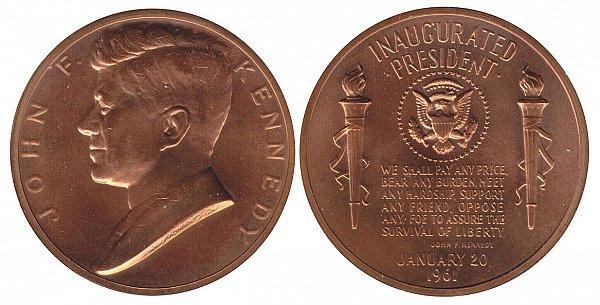
Kennedy Presidential Inauguration Medal, which would be what the Kennedy Half Dollar design was based on. Obverse designed by Gilroy Roberts, Reverse designed by Frank Gasparro.
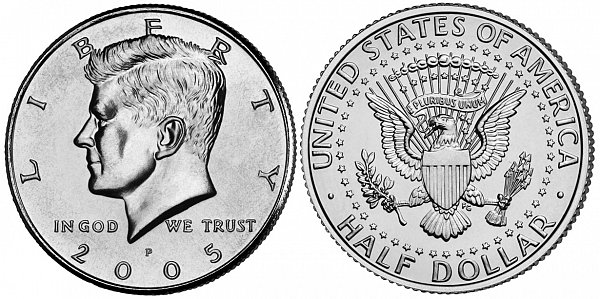
Kennedy Half Dollar - Obverse designed by Gilroy Roberts, Reverse designed by Frank Gasparro.
The Kennedy Half Dollar would be continued through the present date, with Gasparro's reverse only being changed during the US Bicentennial and then restored afterwards. During the first year of production, all coins were 90% silver. The very next year, President Lyndon Johnson signed the Coinage Act of 1965, which put an end to most new publicly circulating silver currency. The value of silver coins was increasing due to the intrinsic silver metal in the coin, which was beginning to become more valuable than the face value of the coin itself. So people began hoarding silver coins and melting them down. The new law changed the metal composition of dimes and quarters from silver to a clad composition of copper and nickel. The half dollar's silver content was reduced to 40% and copper made up 60%.
Eventually in 1971, the composition of the Kennedy Half Dollar changed to full clad with no silver - 91.67% copper and 8.33% nickel, which is the same composition used through the present day. The design would remain the same except during the US Bicentennial when the reverse would be changed to depict the Independence Hall building where the Declaration of Independence and the US Constitution was signed, a coin design produced by Seth G. Huntington. After the Bicentennial, the reverse would be restored to Gasparro's design, which would continue being produced until the present day.
In 1969, Congress became interested in bringing the dollar coin denomination back into circulation. Former US President Dwight D. Eisenhower (also known as Ike), had passed away that same year on March 28, 2969. Many people proposed honoring Eisenhower, including Chief Engraver Frank Gasparro, who had a longtime dream of putting the General of the Army on a US coin. Gasparro was instructed to create the obverse in a layout that was similar to the Washington Quarter. Congress insisted that the reverse of the coin have a design that would commemorate the Apollo 11 landing on the moon. Gasparro produced two eagles; one was a formal heraldic eagle, which looked similar to the designs of the mid-1800s. The other design was the eagle landing on the moon, which was ultimately selected. The reverse is actually modeled after the Apollo 11 mission insignia. This new US dollar would become known as the Eisenhower Dollar.

Apollo 11 Insignia, the model that Frank Gasparro would use for the reverse of the Eisenhower Dollar.
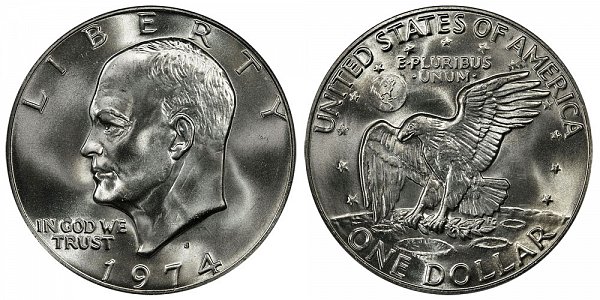
Eisenhower "Ike" Dollar, designed by Frank Gasparro.
The Eisenhower dollar was first minted in 1971 and used the base metal clad composition of 91.67% copper and 8.33% nickel. Although there were silver Eisenhower dollars, which were only 40% silver, but were only produced as uncirculated collectible coins. Many silver Ike dollars were known as "blue Ike", which was encased in an airtight plastic pliofilm holder with a blue seal in it, which came in a blue envelope with certificate. While many silver proof Eisenhower dollars were known as "brown Ikes", which were placed in a plastic holder and put into a brown box with a golden eagle seal on it. President Richard Nixon presented the first "brown Ike" dollar to Mamie Eisenhower, the widow of President Dwight Eisenhower. The design was only changed in 1975 through 1976 during the United States Bicentennial year (200th anniversary) when Frank Gasparro's reverse would be changed to the liberty bell suspended against the moon, which was designed by Dennis R. Williams.
As an American coin designer, Frank Gasparro had one of the greatest honors in American history by designing these coins. President Dwight Eisenhower was actually the one who first established NASA (National Aeronautics and Space Administration) in 1958, essentially beginning the entire United States space program that would be built by the "Greatest Generation" who had recently returned home victorious after World War II. Eisenhower had also conceived the Apollo Space Program in 1960. When President John F. Kennedy came into office, he was eager for the US to forge ahead and become the leader of the space race, and so he set the goal of sending men to the moon within a single decade. On July 20, 1969, Neil Armstrong from Apollo 11, became the first human to step foot on the moon and walk across the surface of another world. It is perhaps the greatest human achievement in the history of our existence and species. To grasp the magnitude of this accomplishment, this is an event that people will still talk about even 10,000 years from now.
In 1976, the Treasury had a study done on circulating Eisenhower dollars. They found that the coin had a near 100% attrition rate, meaning these coins were used only one time in transactions and then stop circulating. Most people simply collected them as commemorative coins after that, so these very large coins were not successful as business currency. The Treasury was also concerned about using too many resources on a coin that did not circulate. So in January of 1977, Treasury Secretary William E. Simon, under President Ford, proposed reducing the size of the dollar. The Mint began experimenting with various ideas for designs and compositions of the new small dollar.
Frank Gasparro and the Mint began coming up with ideas for an 11-sided hendecagon coin with constant-width and experimented with titanium metal. Even at the time, there was fears that the coin would be confused with US Quarters, which is why they experimented with ways to clear up any confusions. Manufacturers of vending machines strongly protested the 11-sided design this because it would be very expensive to re-engineer their machines. Ultimately, Gasparro decided on a round coin with 11 sides on the design of the rim, and that the coin would be slightly larger and thicker than a quarter. His original design of the obverse depicted a flowing hair Liberty bust with a cap on a pole, similar to the old liberty coinage of the 1800s. The reverse depicted a flying eagle in front of the sun and its rays. It looks completely different than the one actually produced.
The intention for the 11-sided coin, was to honor Apollo 11. The 11-sided shape was meant to look like the Apollo 11 Goodwill Message, which is a silicon wafer left on the moon by the crew of Apollo II.
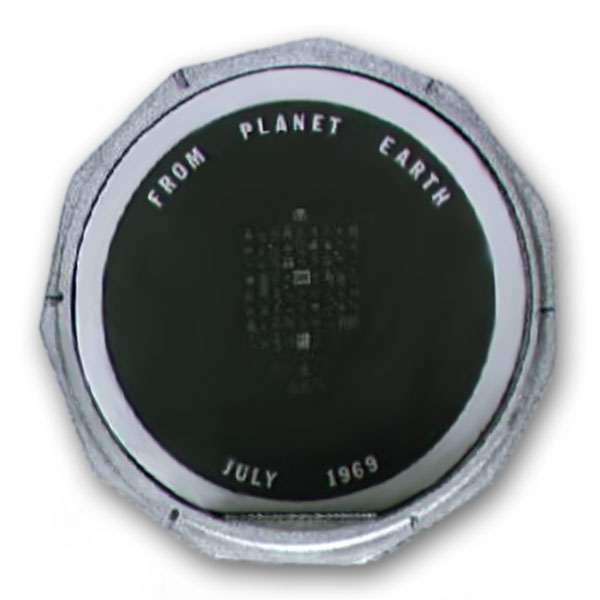
Apollo 11 Goodwill Message, a half-dollar sized silicon wafer left on the moon by the Apollo 11 crew. This was the inspiration behind producing an 11-sided small dollar designed by Frank Gasparro.
Gasparro's original design was accepted at first. Although President Jimmy Carter's Administration and Congress decided it would be a good opportunity to honor Women's Rights. Eventually after debate, Susan B. Anthony became the face that would honor the Women's Rights movement since she was the leader of the women's suffrage movement. Gasparro, who didn't know what Susan B. Anthony looked like, produced two designs based on only two photographs that he could find that depicted her, one when she was 28 years old and one when she was 84 years old. Many women, including Anthony's family, feminists and even his own wife complained about the younger Susan B. Anthony design because she looked too pretty. Anthony's granddaughter complained that the older design made Susan look too old and feeble. So Gasparro, produced a middle-aged rendering of what Susan B. Anthony looked like, and everyone was very happy with the new design for the obverse.
The reverse of the coin was also altered to depict a smaller scale Apollo 11 insignia of the eagle landing on the moon, which was the same design used on the reverse of the larger Eisenhower dollar. The Eisenhower stopped being produced in 1978. Then starting in 1979, the Susan B. Anthony Dollar was first struck and released to the public.
The Susan B. Anthony dollar was only produced until 1981, just 3 years. Like the Eisenhower dollar, it was not circulated very well and oftentimes it was confused with the US Quarter Dollar. The reeded edge, same metal composition, coin diameter and thickness was just too close to the quarter. Most of the time, these were used only once before they were collected as commemorative coins, like the Eisenhower dollar. After it stopped being produced in 1981, it was resurrected again around 18 years later in 1999, at the turn of the Millenium. The coin was only struck in 1999 in honor of Susan B. Anthony and the Women's Rights Movement before the coin would be changed to the small golden Sacagawea dollar, which is more easily distinguishable from the quarter dollar.
The Susan B. Anthony dollar was Frank Gasparro's final US coin design before he retired from the US mint on January 16, 1981 and was replaced by Elizabeth Jones. He had produced many other medals and commemorative coins throughout his career and even after he retired. Some notable medals he produced included portraits of General Douglas MacArthur, Winston Churchill, Albert Gallatin, Sam Rayburn, Lyndon B. Johnson's presidential medal, Ronald Reagan's presidential medal, John Wayne's Congressional gold medal, coins depicting baseball players and Olympic athletes.
After retirement, Frank Gasparro worked as a teacher and taught art at the Samuel S. Fleisher Art Memorial in Philadelphia. He worked there until 3 weeks before he passed away on September 29, 2001 in Havertown, Pennsylvania at the age of 92. He is survived by his wife Julia and their one daughter Christina (Gasparro) Hansen. Gasparro is the single most successful coin design artist in world history. His designs are found on many hundreds of billions of US coins that were produced. Oftentimes when Gasparro was asked what he had designed in his career as a sculptor, he would reply "It's in your pocket!". Gasparro was known to sometimes show off the reverse (tails side) of the Lincoln memorial pennies to random store cashiers, he would announce that he had designed it. Although he said "They look at me like I was crazy, so I don't do it anymore". In just about any handful of change, you will quite literally come across one of his 100s of billions of Lincoln Memorial cents, the most successful of is designs.

